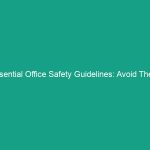Introduction
Good morning team! Today, we’re going to discuss an incredibly important topic: Essential Tool Safety Guidelines: Avoid These Risks in Your Workplace. Tool Safety is essential not just for compliance but for your well-being as well. Understanding how to use tools safely can prevent accidents, injuries, and even fatalities. By adhering to these guidelines, you can help create a safer work Environment for yourself and your colleagues.
Understanding Essential Tool Safety Guidelines
Essential Tool Safety Guidelines refer to the set of practices and protocols designed to ensure the safe use of tools and equipment in the workplace. These guidelines are critical because improper tool use can result in serious injuries, damage to property, and even loss of life. It’s not just about knowing how to use a tool; it’s about understanding the risks involved and how to mitigate them.
Many employees may think, “I’ve used this tool a hundred times, I know what I’m doing.” However, complacency can lead to accidents. Regular Training and adherence to safety guidelines can help keep you sharp and aware of the potential Hazards.
Key Hazards, Risks, and Safety Considerations
Let’s discuss some of the specific hazards associated with tool use:
- Improper Use: Using a tool for a purpose it wasn’t designed for can result in accidents.
- Lack of Personal Protective Equipment (PPE): Not wearing the necessary PPE can lead to severe injuries.
- Equipment Malfunction: Using tools that are damaged or not maintained can increase the risk of accidents.
- Distraction: Working in a noisy environment or being distracted can lead to careless mistakes.
Ignoring these hazards can have serious consequences. For example, a worker who uses a faulty power tool without proper PPE can suffer severe injuries, leading to long-term health issues or even permanent disability. Understanding these risks is the first step in mitigating them.
Best Practices, Procedures, & Actionable Advice
Now, let’s go over some Best Practices and Procedures that everyone should follow when using tools:
Before Using Tools
- Always inspect tools before use. Check for any damage or wear.
- Ensure you are using the right tool for the job.
- Wear appropriate PPE, such as gloves, goggles, and ear protection.
While Using Tools
- Maintain a clean and organized workspace to avoid tripping hazards.
- Stay focused; avoid distractions while operating tools.
- Use tools as intended and follow the manufacturer’s instructions.
After Using Tools
- Clean tools after use and store them in their designated places.
- Report any damaged tools immediately.
- Review any incidents or near misses to improve future safety.
For example, a team member once ignored the importance of inspecting tools before use, which led to an accident that could have been easily prevented. Always remember: a few extra moments spent on safety can save a lifetime of regret.
Regulations, Standards, and Compliance
It’s essential to be aware of the Regulations and Standards that govern tool safety in your workplace. OSHA (Occupational Safety and Health Administration) outlines specific safety standards that must be adhered to. Compliance with these regulations is not just a legal requirement; it’s a moral obligation to ensure the safety of everyone in the workplace.
Understanding these standards helps you realize the importance of proper training and equipment Maintenance. Regular audits and safety meetings can help ensure compliance and keep safety at the forefront of everyone’s mind.
Employee Engagement & Discussion
Now, I want to hear from you! What safety challenges have you encountered related to tool use? Have you ever faced a situation where a lack of tool safety led to an issue? Your experiences can help us all learn and improve our safety practices.
Discussing these topics openly can foster a culture of safety and encourage everyone to take responsibility for their own well-being and that of their coworkers.
Conclusion & Key Takeaways
In conclusion, adhering to Essential Tool Safety Guidelines is critical for maintaining a safe working environment. Remember to:
- Inspect tools before use.
- Wear appropriate PPE.
- Follow manufacturer instructions and safety protocols.
Your safety is paramount. By incorporating these practices into our daily routines, we can significantly reduce the risks associated with tool use. Thank you all for your attention and commitment to making our workplace a safer environment for everyone. Let’s prioritize safety and look out for one another!


